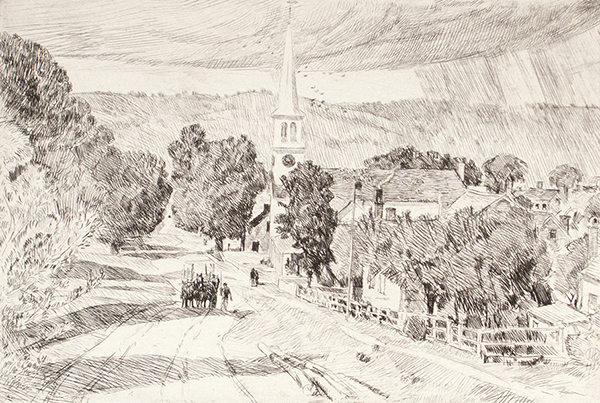
Ever wonder where the art is stored at the WFMA, and what's in there anyway? Join MSU professor Todd Giles as he unlocks the vault!

Childe Hassam
A Vermont Village , 1923
Etching
8 x 11 1/4”
Museum purchase assisted by the National Endowment for the Arts, 1975
[Transcript]
Hello and welcome to The Vault Unlocked. My name is Todd Giles and we’re here to take you inside the collection vault at the Wichita Falls Museum of Art at MSU Texas, because getting to know art helps us better know ourselves. In this episode, we will take a close look at Child Hassam’s 1923 etching A Vermont Village.
Frederick Childe Hassam (1859-1935) was one of the leading proponents of American Impressionism during the turn of the last century alongside Mary Cassatt, whose Baby Held before an Oval Mirror, and John Twachtman, whose Winter Scene Outside of Cincinnati, are likewise held in the WFMA’s permanent collection. Thought by his stateside Impressionist peers as the most important representative of the style, Hassam was also one of the most uniquely American in his subject matter, as seen, for example, in the “Flag series,” a set of some thirty paintings of New York’s Fifth Avenue colorfully strewn with American and Allied flags composed throughout World War One.
Born into a moneyed New England family, Hassam lived most of his life in New York and Boston. Like countless others of nearly every generation of American artists, composers and writers, Hassam spent three years honing his craft in France. Although he had apprenticed as a wood-engraver in Boston in the 1880s, he did not take up printmaking in earnest until 1915; within two years he had produced over one hundred prints, leading to the ongoing composition of some four hundred etchings and lithographs by the end of his lifetime.
Like the French Impressionists who inspired him, Hassam was keenly interested in atmosphere—in depicting the play of light and shadow in all kinds of weather and times of day. Likewise, he believed that it was his duty as an artist to paint his own time, not figures and events out of history or myth. His preferred subjects included bustling upper-class New York street scenes, historic buildings, flower gardens, beautiful sunlit interiors, and historic tree-lined streets and houses.
While his etchings show a precision of line and formal clarity, they also capture the richness and dynamism of his work in oil and watercolor. Hassam’s prints were composed towards the end of his career, at a time when the Ashcan School of social realist painters like George Bellows, Edward Hopper and John Sloan were eschewing their predecessors’ light airiness for something more tactile, more gritty. They had had enough of the genteel urban atmosphere of Fifth Avenue and fancy Long Island summer homes; theirs was an art of the night, of the realities of how the other half lived in the over-populated squalor of the early 20th century metropolis, whereas Hassam’s subject matter focuses on the late 19th leisure class.
A Vermont Village (1923) provides us with an idyllic setting, one depicting the world as it existed prior to the invention of the automobile and the erection of the countless skyscrapers that altered Hassam’s Old New York forever. Recall too that World War One had just ended four years earlier. Edith Wharton writes about this historical moment of change in two of her greatest novels, House of Mirth (1905) and The Age of Innocence (1922). As she says in her autobiography A Backward Glance, writing The Age of Innocence afforded her “a momentary escape in going back to [her] childish memories of a long-vanished America. . . [I]t was growing more and more evident that the world [she] had grown up in and been formed by had been destroyed in 1914.”
One could say the same for the onslaught of Modernism eclipsing what was at one time Childe Hassam’s avant-garde role as a painter. Indeed, one could perhaps refer to A Vermont Village as his own Age of Innocence. It is interesting, and somewhat ironic, that he showed his by then mainstream Impressionist works alongside the likes of radical experimentalists such as Picasso, Cezanne and Duchamp at the Armory Show in New York in 1913, an exhibition that immeasurably changed the face of American and thus international art throughout the 20th century.
In A Vermont Village we can almost feel the slowed-down pace of the rural Peacham village overtake us; almost see the bright oranges and yellows of the fall foliage; and almost hear the tolling bells of Peacham Congregational Church just down the road. Heading along Church Street, the birds take wing as an afternoon shower moves past and the sky begins to clear. As the rain blows towards the north, so too the chimney smoke and lone American flag flying tall above the rooftops along the sidewalk.
Grouped tightly together almost (almost!) in Cubist fashion are some ten or so buildings surely too closely-packed together to exist that way in reality. There are seven chimneys, seven people, and, way off in the distance, a second horse-drawn cart down the road . . . or could that be an automobile? Certainly not; not in this idyllic Vermont village of white picket fences and steeple-top weather vanes!
The more time you spend within this etching, the more impressive Hassam’s artistry becomes—from the play of movement, light and shadow, to the individual characteristics of the various species of trees rustling in the breeze. The thousands of minute lines that give birth to the detail of A Vermont Village are at one and the same time exceedingly precise yet spontaneously alive; it is, for the lack of a better way to put it, impressionistically realistic.
Thanks for joining us as we unlock the vault at the Wichita Falls Museum of Art at MSU Texas. To learn more about the WFMA, our current and upcoming exhibitions, the permanent collection, as well as sign up for our e-newsletter, visit wfma.msutexas.edu.
Works Consulted
Czestochowski, Joseph S. 94 Prints by Childe Hassam. Dover Publications, 1980.
Hiesinger, Ulrich W. Childe Hassam, American Impressionist. Prestel, 1994.
A Vermont Village from the Permanent Collection of the Wichita Falls Museum of Art at MSU Texas
View Previous The Vault Unlocked
-
Tuesday - Friday
10:00AM - 5:00PMSaturday
1:00PM - 5:00PM